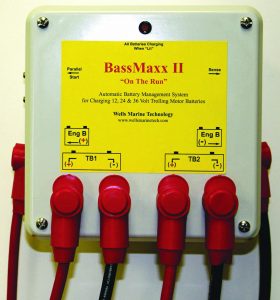July 19, 2012
By Frank Sargeant
Why go around hungry for juice?
Originally Published in February 2009.
 Onboard charger supplies engine alternator current to accessory batteries.
Onboard charger supplies engine alternator current to accessory batteries.
A couple of big deep-cycle batteries can handle the power needs of most boats on most days, and the alternator of a modern outboard should keep the starting batteries happy. Still, most of us have seen a few trips where at least the trolling motor gets tired. If those same batteries also keep your sardines swimming and your shrimp flipping, you may wish for an injection of electrons while you're still in the midst of your fishing day.
Onboard chargers, a.k.a. battery isolators, can alleviate this worry. These systems tap into the charge being generated by the outboard any time it's running and feed it to your accessory batteries.
If you run a reasonable amount of time each day, they're likely to provide enough juice to keep your trollers and baitwells happy. And with the deep cycles at near full charge, you'll also have confidence that you can jump off the outboard should your starter batteries suddenly decide to become anchors instead of power generators.
Companies that make these products point out that regular recharging of deep cycles during the day greatly extends their lifespan.
Minn Kota makes units designed for 12-, 24- or 36-volt systems, and prices range from under $100 to around $170. Wiring is relatively simple on most boats; one wire runs from the positive terminal on your alternator to the isolator. A wire from the isolator runs to the plus terminal of your main battery, and a second wire runs to the positive terminal of the auxiliary or deep cycle. Each battery is also connected to the system via a ground wire. For two deep cycles, a third wire from the isolator connects to the positive terminal of the second deep cycle. Isolators produce heat, so they have to be mounted so that the cooling fins are unobstructed. And it's best not to install them on carpeted surfaces, or anything else that might be damaged by heat.
 BassMaxII from Wells Marine Technology.
BassMaxII from Wells Marine Technology.
Wells Marine Technology makes the BassMax II, a single unit which will charge 12-, 24- or 36-volt systems, and also has an emergency start parallel switch that allows you to tap the deep cycles at the flip of a lever to kick off the outboard, should you ever need it. It sells for about $280. The 2530 Isolator from Guest is a 120-amp model that goes for about $120 in the two-battery version.
If you typically run five minutes to a fishing spot, work the shoreline there for an hour, then run 10 more minutes, the motor may not run long enough to do you much good. On the other hand, if you run for an hour to get to your spot then odds are the system could give you a big boost when you need it.
Battery Check
Regular charging and battery service go hand in hand. If you have flooded maintenance batteries (removable vent caps), remember to check water levels regularly and add distilled water to keep the lead plates covered. With any battery, keep the terminals clean and corrosion-free, and make sure connections are tight.
Charge on the Tow
Trailering long distances? Consider a hookup to tap the charging system of your truck, so you can top off batteries all the way to the ramp and all the way back home. I especially like the latter; when you're tired after a day on the water, you may not have the energy to juice up your troller. The conjoined charge from the time the deep-cycle is hooked to the truck and to your outboard should keep batteries topped off no matter how long you stay on the water. Wells Marine makes one of these for the BassMaxx II, right, called the HitchHyker, for around $115.
FS
